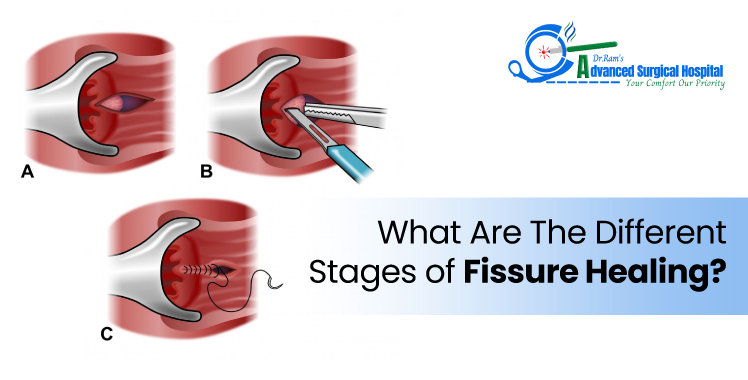What are the Different Stages of Fissure Healing?

Ever wondered how your body heals something like an anal fissure(a small tear or cut in the lining of the anus)? It’s not just a matter of applying cream and crossing your fingers. There’s an entire behind-the-scenes healing process happening, stage by stage. And the more you know about it, the better you’ll feel navigating it. So, visit Dr Ram’s Advance Surgical Hospital for Fissure Treatment in Ahmedabad to discuss your condition. Now, let's break down the stages of fissure healing in words you can understand.
So, what occurs as a fissure begins to heal? Let's break down the steps of fissure healing simply and understandably.
Stage 1: What’s going on? phase
This is the beginning, when you first feel the pain, usually during or after a bowel movement. You might even spot a bit of blood. At this point, your body is trying to tell you you have a tear and starts kicking off the healing process.
What can you do? This is the best time to act fast, drink more water, add fibre to your meals, and avoid straining. The quicker you catch it, the better.
Stage 2: Inflammation takes the spotlight
Your body’s little army, white blood cells and healing agents, are dispatched to the torn spot, which means inflammation. You will most likely experience some pain and possibly some swelling, but this is your body working.
What you’ll feel : Burning pain while going to the bathroom, itching. It feels irritating, but it’s part of the process.
Pro tip : Warm sitz baths are glorious in this phase. They prevent the anal muscles from spasming and help return blood flow to normal, so healing occurs faster.
Stage 3: The repair mode kicks in
Here’s where things start getting better. The tear starts forming new tissue. It’s like when a scab forms on a cut—same idea, just in a more sensitive spot.
What to expect : Pain starts reducing slowly. You might feel a dull ache, but it’s way better than before.
Keep at it : Don’t stop the healthy habits now. Stick to your fibre-rich diet, keep hydrating, and avoid long toilet sessions. This stage needs consistency to move forward.
Stage 4: Scar tissue and regeneration
By now, your fissure is closing up. The skin is trying to regenerate fully and return to normal. You’re almost there!
You might still feel a bit of tightness or irritation from time to time, especially if you go off track with your diet. But overall, things are looking up.
Keep going : Gentle movement, light exercise, and avoiding constipation are still key during this phase.
Stage 5: Fully healed
The sweet relief! No more pain while pooping. No more fear of the bathroom. You can go about your day without constantly thinking about your backside.
But here’s the thing—just because the fissure has gone doesn’t mean it can’t come back. So, even though you have made it through all the stages of fissure healing, maintaining those lifestyle changes is super important to prevent future episodes.
A Quick Note on Chronic Fissures
If your fissure isn’t healing even after 6 to 8 weeks, it may have turned into a chronic fissure. That simply means the tear hasn’t fully closed and needs a bit more than just home care. At this stage, your doctor might recommend topical treatments to relax the muscles and improve blood flow. In some stubborn cases, a small surgical procedure might be suggested. Sounds scary? Don’t stress—chronic fissures are treatable, and you’re not the only one going through it.
Tips to Speed Up Anal Fissure Healing
Hydrate like it’s your job
Water keeps your stool soft and helps avoid that painful strain.
Get serious about fibre
Oats, fruits, veggies, and whole grains are your new best friends.
Sitz baths are magic.
Bathing with warm water for 15–20 minutes (twice a day) can ease pain and speed up healing.
And finally! See a doctor if things aren’t improving
If the pain isn’t getting better within a few weeks, or if getting worse, don’t wait it out. Chronic fissures sometimes need prescription ointments or minor procedures. Getting medical help early can save you from months of unnecessary pain.
Healing a fissure isn’t just about applying a cream and hoping for the best. It’s a process—a journey your body goes through step by step. Understanding the stages of fissure healing makes the whole thing less scary, don’t you think? But don’t worry, by visiting Dr Ram’s Advance Surgical Hospital, you can ease this process.
So, listen to your body, be kind to your gut, and most importantly, don’t ignore the signs. Early care does make all the difference when it comes to fissures.
